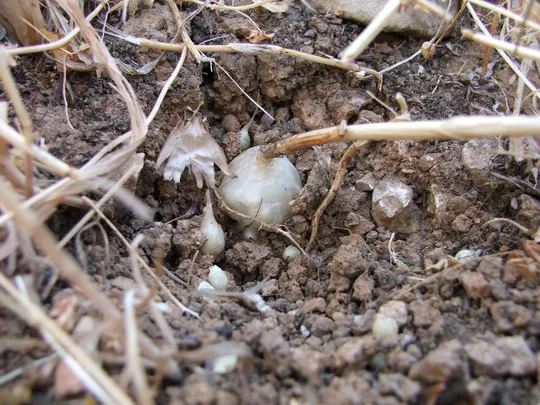Papillous Garlic
Allium papillare


Allium papillare grows in only one
region – the western Negev, where it is found on five sites that were
documented with certainty, although apparently there are a total of six sites.
It is found in the region of Kerem
Shalom, along the Rafiah-Nitsana
highway, in Sde Halamish and on the Revivim-Tse'elim highway. It is extinct
from the area of Gvulot-Nirim, from where Zohari and Orshan collected it in
1954.
Sand-loess flats
dominated by shrub and dwarf shrub associations of desert sands.
The genus Allium
has about 700 species growing in the Northern Hemisphere. It is the largest
genus in the class Monocotyledoneae – with the exception of the Orchidaceae
family (Gregory et al., 1998). The genus Allium and a few other close genera were moved from the Liliaceae family to
the Alliaceae family for morphological, genetic, and chemical reasons to
(Heywood, 2007).
The Allium
species are divided into several sections and A. papillare
belongs to the section Molium. Most species of this section grow in the
Mediterranean Basin and its periphery and one species grows in Iran to the east
(Coleman, 1985). These species are very close to each other and have a
characteristic small bulb, flat leaves attached to the lower part of the stem
and many of them have quite large white, yellow or pink flowers (Coleman,
1985). Eight species from this section are found in Israel. There are three
species in the Israeli desert – A. erdelii
characterized by very hairy leaves, A. negevense
(see entry), and A. qasyunense.
The three species are close to each other and differ from A. papillare
in their thinner and longer stalk.
Some species of Allium
are cultivated as vegetables or spices. The best known include A. cepa, the "common onion" and A. sativum,
garlic. These two species are also known as multipurpose medicinal plants in
natural medicine.
·
The distribution of Allium papillare is limited to
a few sites on sandy – loess areas in the western Negev. Most of the observations
are updated only up to the mid-1990s and there is no clear information on
change trends in the number of sites.
·
The populations usually number single to tens of plants.
·
The conversion of sandy areas to agricultural use south of
Kerem Shalom and military operations have reduced the habitat of the species
and could result in a decrease of populations. The small size of the
populations are also a threat factor.
·
The plant is not protected in declared nature reserves.
·
A. papillare grows only in Israel and Egypt, but is
not included in the list of endangered plant species of Egypt.
New surveys should
be conducted in sandy-loess areas in the western Negev, particularly in the
areas south of Kerem Shalom towards the Halutsa Sands and in the area of Tse'elim-Gvulot-Revivim.
A nature reserve should be declared in this unique habitat or at least local
conservation sites should be established in A. papillare
habitats. Backup populations should be cultivated immediately in refuge
gardens.
Allium papillare is a narrowly distributed
species that grows only in southern Israel and Egypt (the sandy coastal plain
of Northern Sinai and northern Egypt in Africa).
Allium papillare
is a short geophyte of loess-sand in the western Negev. It is very rare and
endemic to Israel, Sinai and sandy areas in northern Egypt. Its habitat is
endangered by agricultural development and military activities.
קולמן, פ. 1985. הסוג שום בישראל. רתם 15: 34.
Gregory, M., Fritsch, R., Friesen, N.WE, Furkat, O., Khassanov, O. & McNeal, W. 1998. Nomenclator Alliuorum. Kew.
Current Occupancy Map
| 1000 squre meter pixel | 5000 squre meter pixel | 10000 squre meter pixel | |
|---|---|---|---|
| number of observations | 0 | 0 | 0 |
| in total pixels | 0 | 0 | 0 |
| Family | Liliaceae |
| Classification | On the endangered species list |
| Ecosystem | Desert |
| Chorotype | Eastern Saharo - Arab |
| Conservation Site | "Steel Division" Memorial near Kerem Shalom |
| Rarity |
1
2
6
|
|---|---|
| Vulnerability |
0
3
4
|
| Attractiveness |
0
0
4
|
| Endemism |
0
2
4
|
| Red number |
1
4.2
10
|
| Peripherality | E |
| IUCN category | DD EW EX LC CR EN VU NT |
| Threat Definition according to the red book | Endangered |
 Based on:
Based on:






